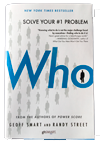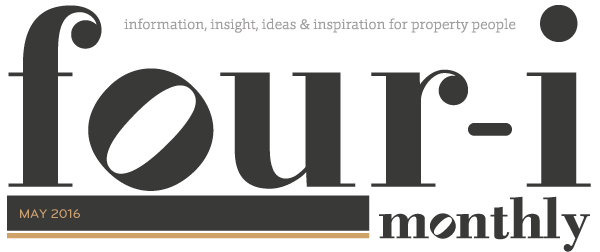Who by Geoff Smart and Randy Street
 “The most important decisions that people make are not what decisions, but who decisions.”
“The most important decisions that people make are not what decisions, but who decisions.”
(Jim Collins, author of Good to Great)
The premise above underpins the whole of Geoff Smart and Randy Street’s book Who, which begins with the assumption that your number one business problem is recruiting. They quote business gurus who estimate that the average success rate of managers when hiring is a paltry and often very expensive 50%, and that by avoiding common pitfalls and actively including recruitment in your business activities (using their tried and tested method), you will dramatically improve the quality of your recruitment process and therefore your company’s wellbeing and performance.
Smart and Street run ghSMART, an advisory firm using expertise in human behaviour to help CEOs and investors build valuable companies. With a background in thorough and unique business research (using various partners and hours of interviews with CEOs of successful companies all over the world), they have created a hiring method which they claim has helped businesses make over 12,000 smarter recruiting decisions.
The aim of the book is to help you make better ‘Who’ decisions so that the people you put in place to make ‘what’ decisions are A Players (after all, no-one would deliberately set out to create a B or C-list team). The Who method itself is straightforward and structured to create a scenario where recruitment is based on deep knowledge, rather than luck, or “voodoo”. As Steve Kerr, former MD at Goldman Sachs points out: “otherwise smart people struggle to hire strangers”. Smart and Street outline many of the common traps managers and recruiters fall into in the absence of a decent process, e.g. trying to impress candidates by talking, not listening; going by gut instinct; setting trick questions completely unrelated to the skills required for the role; and simply not committing enough time to widening the net to find great candidates.
When it comes to CVs, Smart and Street quote George Bucklely, CEO of two Fortune 500 companies: “What is a resume? It is a record of a person’s career with all of the accomplishments embellished and all the failures removed”. They maintain that using an average or haphazard recruitment process makes it hard to see people for what they really are, so it is best to follow a structure to make sure you capture all the information you need to make a good hiring decision. They call their four-step process the A Method, and while I’ve summarised it below, if you are serious about improving your company’s recruitment I urge you to read the book in full – the change of method will be a culture shock, and the level of commitment required at management level is not to be underestimated.
1. Scorecard: A Blueprint for Success
The Scorecard has evolved from the traditional job specification. It outlines Mission, Outcomes and Competencies. It is detailed and specific, so that it points to what a person needs to be in order to accomplish the goals of the role required, and it should dovetail into the business’s plans and other team members’ own Scorecards, spreading strategy around the business and forcing managers to be consistent.
The Mission will state the job’s core purpose in clear language, the Outcomes will be objective, measurable criteria (which also have the advantage of scaring off B and C Players), and the Competencies will be directly related to the Outcomes. Smart and Street provide a comprehensive list of the top quoted A Player competencies to get your juices flowing.
2. Source: Generating a Flow of A Players
Fully 77% of top business people questioned said that their best hires came from referrals from their business and personal networks. Who suggests a really pro-active approach to mining this rich source of candidates, using the foremost question routinely asked by Patrick Ryan at Aon: “Who are the most talented people you know that I should hire?”. As a regular discipline, this question should be addressed to people from all of your networks including customers, partners and suppliers, professional organisations, and importantly, from your own team – it takes an A Player to know an A Player. In addition, if making referrals becomes a habit for your colleagues, they will begin to see the organisation through a ‘Who’ lens, not just a ‘what’ one.
Smart and Street encourage managers to schedule regular time to create and maintain relationships with potential candidates, before roles become available, so that there is always a flow of A Players coming through. They provide lots of help with this, and claim that by owning the process, focus and commitment will reap great rewards. They also suggest treating external recruiters as partners who should have plenty of access to the business to ensure they are filtering the right candidates. The Scorecard is essential for this.
3. Select: The Four Interviews for Spotting A Players
This interview process is thorough and should weed out any unsuitable candidates, however it does require thought, a substantial commitment of time and also absolute consistency across the recruiting team.
1. The Screening Interview – culling the list
This is a short phone interview following which, if you have any hesitation, screen the candidate out. It’s essential to the whole process to follow the prescribed questions, which should actually make things easy. Start by explaining how the interview will work, and that there will be time for questions at the end. Probe and encourage answers by “getting curious”, asking open questions to find out more: What, How, Tell me more…
- What are your career goals?
Allows candidate to talk first, and you can then see if their goals match the company’s needs - What are you really good at professionally?
Push for 8 – 12 of these including examples. You are looking for strengths to match the scorecard. - What are you not good at or not interested in doing professionally?
Push for 5+, and if something sounds like a strength (I work too hard) then probe for actual weaknesses - Who were your last five bosses, and how will they each rate your performance on a 1-10 scale when we talk to them?
Emphasis on the ‘when’ will make them honest, and you are looking for 8s, 9s and 10s.
2. The Who Interview – the power of patters for choosing who
This key part of the process is a chronological walk-through of a person’s career – through someone’s story you are looking for patterns to help you predict what their strengths and weaknesses, and performance, will be. You ask the same five questions for each job in the last fifteen years, and while this can take hours, Smart and Street maintain that this well-spent time will eliminate your B and C Players, and therefore hugely reduce your hiring failure rate – remember, time invested at this stage is surely better than time spent managing someone out. They also offer some great interview tactics.
The five questions are:
- What were you hired to do?
- What accomplishments are you most proud of?
- What were some low points during that job?
- Who were the people you worked with? Specifically:
– Boss’s name, what they were like to work with, what they’ll say about you
– What was the team like when you started and when you left? - Why did you leave that job?
3. The Focused Interview – getting to know more
This interview stage is about methodically addressing the specific outcomes and competencies of the scorecard, using different members of the team who are focused and not just re-hashing the Who interview. It also give you an insight into cultural fit. The questions for each interviewer, according to the particular parts of the scorecard they are covering, are:
- The purpose of this interview is to talk about….
- What are your biggest accomplishments in this area during your career?
- What are your insights into your biggest mistakes and lessons learned in this area?
4. The Reference Interview – testing what you learned
Smart and Street place huge emphasis on speaking to previous bosses, so having gathered the recruiting team together and decided on any candidates who are now in the running, they suggest personally calling seven references and give some great tips around this. However it would be worth checking the legal implications on this as referencing and what you are and are not allowed to ask is (as we are all aware) a hot topic in HR in the UK!
This final stage of the interview process concludes with a brief but comprehensive method of evaluating the candidates you have seen thus far, and then elaborates on the final stage:
4. Sell: The Top Five Ways to Seal the Deal
Selling, like sourcing, should be a continuous process. Underlying this is your effective identification during the interview process of which of the “five F’s” (below) are going to be important, assuming you are interviewing a candidate with potential. (Incidentally, this identification will also give you an advantage in helping you “on-board” and retain your new recruit). The five areas to address with the candidate throughout the process are:
Fit
Family
Freedom
Fortune
Fun
The final section of Who outlines ten things you need to do to install the A method in your company, and offers tips on avoiding pitfalls. Interestingly, Smart and Street advise against hiring generalist all-rounders, or star-athletes who want the spotlight – the former are in danger of not having deep enough knowledge to do what you are asking of them, and the latter may be very productive but to the detriment of morale if they do not fit the team’s culture. On culture, they also write that before recruitment begins, a company must be clear on its culture. “Part of successful hiring means having the discipline to pass on talented people who are not a fit” (Jeff Aronson).
As you would expect from recruitment professionals, the book is liberally peppered with examples throughout, and therefore very easy to understand. Helpfully a succinct summary is provided at the end of each chapter/stage for reference and transferability. Who is a book which sees great recruitment as fundamental to the success of any company, and as such takes its process seriously. Anyone embarking on the Smart/Street A Method will need to fully commit to this process, and it appears the results could be very powerful indeed.
![]()
